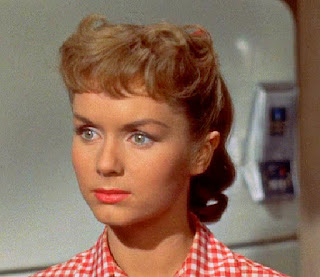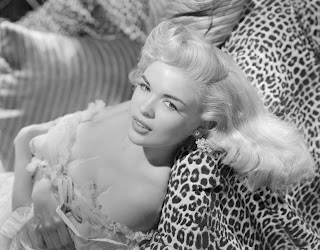Susan Slept Here: This 1954 holiday set romantic comedy is actually narrated by an Oscar statuette! A struggling veteran screenwriter, played by the former baby-faced tenor of 30′s musicals Dick Powell, is surprised to find a spunky juvenile delinquent under the Christmas tree. It’s Debbie Reynolds, just a couple of years after the classic SINGIN’ IN THE RAIN. Also in the cast are future TV stars Anne Francis (“Honey West”) and Alvy Moore (Mr. Kimball on “Green Acres”). This is one of the early feature films directed by former Loony Tunes animator/director Frank Tashlin.
Later Tashlin would guide the movie careers of Jayne Mansfield and Jerry Lewis. Tashlin's mastery of color and the general visual impact within the frame is evident much as it would be on Will Success Spoil Rock Hunter? three years later. The former animator included less purely visual gags on Susan Slept Here but what he did come up with, like the placement of the Navy anchor on Mark's friend Virgil (Alvy Moore), is typically brilliant, if subtle. The hues are dazzling also, throughout the movie but especially in a strange musical dream sequence that, despite the presence of two great stars of the genre in Powell and Reynolds, comes out of nowhere in terms of the plot.
Vincente Minnelli deservedly gets a lot of credit for his use of color but Tashlin is right there too. His star is simply not as high, and his career was much shorter. Frank Tashlin was one of the best of the fifties Hollywood directors both at working with color and at directing comedy. His smart but zany style of the latter plays today like a natural continuation of the screwball comedies of the thirties and forties. An overlooked Christmas classic, Susan Slept Here is sweet and heartwarming at its core, yet refreshingly caustic around the edges. Source: www.wearemoviegeeks.com
Regardless of whether it is character or situation that provides Tashlin with an opportunity for sexual comedy, he seizes it; both cases give him the chance to push the limits of blue humor. Susan Slept Here is one of Tashlin’s most risqué films. A major hallmark of Tashlin’s style is that his sexual gags are both extremely blue and creatively and thoroughly ambiguous. In Susan Slept Here, Susan remarks on the blonde hair of Mark’s fiancée, opining that she has gotten a “dye job”; Mark insists that she’s a natural blonde. “You sure?” asks Susan, to which Mark says, “We’re very good friends. [pause] She told me.” —"Tashlinesque: The Hollywood comedies of Frank Tashlin" (2012) by Ethan de Seife
On Christmas Eve of 1949, Vera Jayne Palmer (Jayne Mansfield) attended a party with her girlfriends. Paul Mansfield was invited to the party also. Jayne immediately had a crush for the black haired, mature looking twenty year old guy. “It was the most conservative Christmas Eve I ever spent. He was not a great talker. He had a silent way of moving and in taking over. I liked that and I was enveloped by his subtle masculinity. I mean the firmness with which he handled himself. I respected him.” Another man, a twenty-four year old gas station attendant, called ‘Inky’ by Jayne, took her to several parties during the holiday season. He also bought Jayne her first alcoholic drink. First timer Jayne drank way too much, so Inky decided to leave and get some coffee and something to eat to sober her up. “On the way home we stopped in the park. Inky kissed me. All the rest followed. I was certainly ready and willing. It was my first time.” Around this time Jayne found out that she was pregnant. Not daring to tell her parents, she called Paul. He directly offered to marry her. Paul Mansfield remembered the following from that period: “Late January we just decided to elope. We didn’t tell anybody about it. She was sixteen, I was twenty-one. I was young and in love and she was too. We got married in a fever, hotter than a couple of cats.”
But once installed in Hollywood, Paul Mansfield started to get annoyed with his wife’s career hunt: “I had began to not like what I saw and I told her that. I just couldn’t stand the attention she was receiving from other men. I didn’t know how we were going to take care of little Jayne Marie in a family with that kind of atmosphere. So along about the Spring of 1955 we separated and I took a job in San Francisco and moved away.” Although Paul remembers it being the Spring, Jayne and Paul actually separated on January 7, 1955. Later Jayne told Raymond Strait about her break up with Paul: “Hollywood broke up our marriage—my desire for stardom. I was a real bitch after we came to Hollywood.” Still aiming a career as a movie star, Jayne boosted her career with the help of Bill Shiffrin, who became Jayne’s agent. Because he believed Hollywood could use another blonde glamour girl besides Kim Novak and Marilyn Monroe, he took Jayne in as a client.
In their earlier film The Girl Can’t Help It, Tashlin let Jayne portray a super sexy girl who was unaware of her physique, but in Will Success Spoil Rock Hunter? Jayne played completely the opposite as the star who used her built to gain publicity and fame for her own success. The character Rita Marlowe is the most crucial role of Jayne’s career. The part brought her fame on Broadway, and upon her return to Hollywood she wasn’t the pin-up starlet when she left for the East coast, but achieved the status of an important celebrity who had the opportunity of becoming a mega star.
Besides this new career perspective, the part and name of Rita Marlowe of course stands for all that Jayne Mansfield desired to be when she was dreaming of becoming a well known and beloved movie star and all that she became and stood for in real life as the outrageous, publicity keen glamour star the world had come to know. Most critics were enthused with Jayne and the movie, but some thought it to be vulgar and in bad taste. In her autobiography Jayne showed a hint of insight on the effect of her being typecast as a sexpot: “My new bosses at 20th-Fox had to realize they had signed a star personality. My publicity continued to make the papers every day. I was invited to big parties and premieres. But this wasn’t enough. I needed to prove that I could act too. I proved something to Broadway, but could I to Hollywood? So the picture was made and I never worked so hard. It was released and was a big success. The critics liked my dizzy, extroverted, funny Rita Marlowe. I was a hit. I had arrived on all levels.”
Will Success Spoil Rock Hunter? started filming on March 19, 1957. Tashlin called it a wrap on May 2. Since Paramount studios producer Hal Wallis didn’t allow Tashlin to use comedian Jerry Lewis for the part of George Schmidlapp, he cast Groucho Marx at the end of shooting. Jayne made clear she preferred Lewis but she agreed to come back to the studio to shoot her scene with Marx on June 10. The movie was released June 29th, 1957. 20th Century Fox planned a publicity tour through 16 European countries for Jayne. On September 25th, she arrived in England. In October she visited Belgium, The Netherlands, Germany, Bulgaria, France, Italy and Sweden. On November 6, 1957 Jayne arrived in Los Angeles. In the United States only the film brought in $1.4 million for 20th Century Fox. In 2000, Will Success Spoil Rock Hunter? was selected for preservation in the United States National Film Registry by the Library of Congress as being “culturally, historically, or aesthetically significant”. —"Affectionately, Jayne Mansfield" (2012) by Richard Koper.






















No comments :
Post a Comment